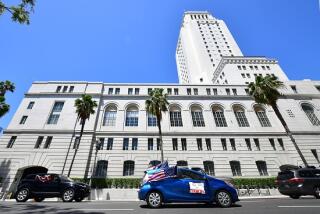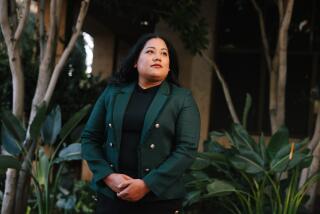Anaheim’s perilous voting path
With about 350,000 residents, Anaheim is by far the largest city in California that still holds citywide votes to elect every member of its governing body. One result is that Mayor Tom Tait and three of the four other members of the City Council hail from the Anaheim Hills neighborhood on the east side of town, miles — and worlds, seemingly — from most of the people they represent.
On Wednesday, Tait proposed a way to guarantee that the council’s power be spread more evenly across the city: a ballot initiative in November that would divide Anaheim into six districts, each electing its own representative. The council’s majority put the kibosh on Tait’s proposal, however, blowing its chance to dissipate some of the tension that’s been building among the city’s growing Latino population.
The at-large voting system is a holdover from an era when Anaheim was a sleepy and predominantly white suburb, although even in the pre-Disneyland years it was home to many Latino farm workers. Now, it is ethnically diverse, with enclaves of Muslim and Christian Arabs in addition to Latinos. The latter make up more than half the city’s residents, although less than half of its registered voters.
PHOTOS: Residents pack Anaheim town hall
The voting system has made it unusual, though not impossible, for nonwhite candidates to win office; only a handful have done so in the city’s history. At-large voting by its very nature diminishes the ability of minority groups to elect representatives of their choice from their communities. That’s why the American Civil Liberties Union filed suit against the city earlier this year, alleging that its voting system harmed Latinos in violation of the California Voting Rights Act.
At-large races also multiply the cost of running for election, enabling a handful of deep-pocketed interests — such as the pro-business political action committee for the resort district around Disneyland, called Support Our Anaheim Resort — to play the role of kingmakers. Shifting to district races would lower the financial barrier to running, diminishing the clout of those groups.
Having council members who better represent all segments of Anaheim and reducing the importance of money in local elections are reasons enough to divide the council into districts. But there’s another justification for the change. Despite the community policing efforts and outreach by Police Chief John Welter, the relationship between city authorities and the Latino community is badly strained. The clearest sign of the problem is the sustained protests that rocked the city last month after a fatal shooting by police in the Anna Drive neighborhood. With gang-related crime and violence surging, the city urgently needs to mend the ruptured trust between police and the residents who live in the line of fire.
That’s a daunting challenge, particularly given the number of undocumented immigrants in those neighborhoods who are understandably skittish in their dealings with law enforcement. But even Latino citizens and legal residents complain that their voices aren’t being heard in City Hall.
Replacing at-large elections with district voting wouldn’t solve the problem overnight, but it would be an important step toward greater civic engagement by Latinos and responsiveness by government. Yet the council had never formally considered such a change until Tait — acting before the shooting — put it on the agenda. After initially favoring four districts, he ultimately proposed a ballot measure that would create an independent commission to draw the lines for six. That would leave each district with about 50,000 residents, which is in line with what other California cities of similar size have done.
Only Councilwoman Lorri Galloway joined Tait in supporting the ballot measure, with council members Kris Murray, Harry Sidhu and Gail Eastman opposed. The council decided instead to appoint a committee to study the issue and make recommendations. Not surprisingly, that mirrored the views in a letter to the council from Disneyland Resort President George A. Kalogridis, who endorsed the idea of putting district elections on “an upcoming ballot” but urged the council to hold a “citywide dialogue” with residents and employers regarding the number of districts, their boundaries and “a new governance structure for the city.”
It’s not unreasonable for the council to want more input than it received from the single public workshop it held on the issue. Nevertheless, the change is long overdue, and now the council has raised suspicions that it’s trying to bury the idea until proponents lose interest. The city can answer skeptics by immediately naming committee members committed to the idea of district elections, and giving them an expeditious timetable for coming up with a new proposal for a ballot measure. Or it can keep dithering until a court, prodded by the ACLU, tells it to stop diluting Latino voting power.
More to Read
A cure for the common opinion
Get thought-provoking perspectives with our weekly newsletter.
You may occasionally receive promotional content from the Los Angeles Times.






